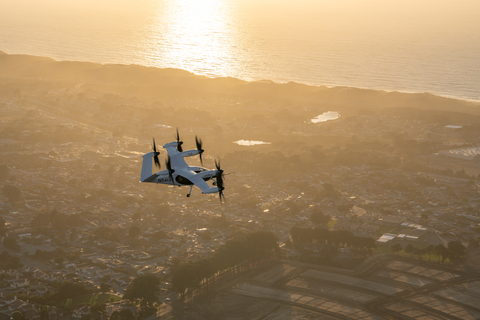Joby Aviation, Inc. (NYSE:JOBY), a company developing electric air taxis for commercial passenger service, today announced it has completed a landmark series of major aerostructure tests for certification credit with the Federal Aviation Administration (“FAA”).
This press release features multimedia. View the full release here: https://www.businesswire.com/news/home/20241217515455/en/

A Joby electric air taxi in flight above Marina, California. Photo: Joby Aviation
Joby has successfully completed static load testing of the tail structure, marking the first time the Company has tested a major aerostructure of its aircraft for-credit with FAA representatives present. The tests took place in Santa Cruz, CA, as part of a rigorous testing campaign covering all of the structures, components, and systems on the aircraft, producing data that is required for FAA type certification of the aircraft.
“Completing for-credit static load testing on a major aircraft structure marks an important step towards certification of the Joby aircraft and we’re very pleased with the results. Reaching this milestone is the culmination of years of hard work across the engineering, testing, certification, and manufacturing teams at Joby,” said Didier Papadopoulos, President of Aircraft OEM at Joby.
“Our vertically-integrated approach to aircraft development gives us the capability to design, build, and test entire aerostructures in-house, providing Joby with a strong foundation to rapidly and efficiently continue to bring innovative technologies to market.”
During the tests, Joby engineers applied loads to the aircraft's tail structure that far exceed the maximum forces the structure is expected to experience during flight. The FAA-conforming tail structure used in the test, along with the test procedure, instrumentation, and applied loads, are outlined in Joby's certification documents, which have been approved by the FAA as part of the certification process.
Joby’s electric air taxi is designed to carry a pilot and up to four passengers at speeds of up to 200 mph, offering high-speed mobility with a fraction of the noise produced by helicopters and zero operating emissions.
About Joby
Joby Aviation, Inc. (NYSE:JOBY) is a California-based transportation company developing an all-electric, vertical take-off and landing air taxi which it intends to operate as part of a fast, quiet, and convenient service in cities around the world. To learn more, visit www.jobyaviation.com.
Forward Looking Statements
This release contains “forward-looking statements” within the meaning of the “safe harbor” provisions of the Private Securities Litigation Reform Act of 1995, including but not limited to, statements regarding the development and performance of our aircraft, the growth of our manufacturing capabilities, our regulatory outlook, progress and timing, the expected timing of type certification; our business plan, objectives, goals and market opportunity; our current expectations relating to our business, financial condition, results of operations, prospects, capital needs and growth of our operations; and the expected benefits of our vertically-integrated business model, including the ability to rapidly bring new technologies to market. You can identify forward-looking statements by the fact that they do not relate strictly to historical or current facts. These statements may include words such as “anticipate”, “estimate”, “expect”, “project”, “plan”, “intend”, “believe”, “may”, “will”, “should”, “can have”, “likely” and other words and terms of similar meaning in connection with any discussion of the timing or nature of future operating or financial performance or other events. All forward looking statements are subject to risks and uncertainties that may cause actual results to differ materially, including: our ability to launch our air taxi service and the growth of the urban air mobility market generally; our ability to produce aircraft that meet our performance expectations in the volumes and on the timelines that we project; the competitive environment in which we operate; our future capital needs; our ability to adequately protect and enforce our intellectual property rights; our ability to effectively respond to evolving regulations and standards relating to our aircraft; our reliance on third-party suppliers and service partners; uncertainties related to our estimates of the size of the market for our service and future revenue opportunities; and other important factors discussed in the section titled “Risk Factors” in our Annual Report on Form 10-K, filed with the Securities and Exchange Commission (the “SEC”) on February 27, 2024, our Quarterly Report on Form 10-Q, filed with the SEC on November 6, 2024, and in future filings and other reports we file with or furnish to the SEC. Any such forward-looking statements represent management’s estimates and beliefs as of the date of this release. While we may elect to update such forward-looking statements at some point in the future, we disclaim any obligation to do so, even if subsequent events cause our views to change.
View source version on businesswire.com: https://www.businesswire.com/news/home/20241217515455/en/
Contacts
Joby Aviation
Investors:
investors@jobyaviation.com
Media:
press@jobyaviation.com
